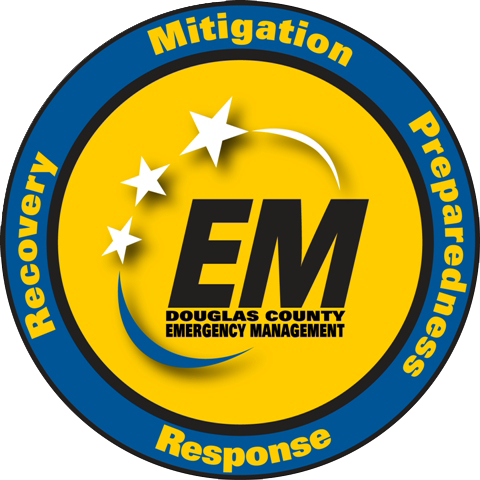Emergency Management
Floods and Flash Floods
Floods are one of the most common hazards in the United States, and Douglas County has had its share of destructive floods. This page contains information to help you prepare for and recover from floods and flash floods.
Before a Flood
Here are a few steps to take before a flood occurs.
- Develop a family emergency plan – Plan and practice a flood evacuation route from your home, work or school that takes you to higher ground. Make sure your family knows how to contact one another in the event of an emergency, and ask an out-of-state relative or friend to be your emergency family contact. (And don’t forget to plan for your children and pets.)
- Complete a Preparedness Kit — Include a first aid kit, nonperishable food, bottled water, rubber boots, rubber gloves, NOAA Weather Radio, battery-powered AM/FM radio, flashlight, and extra batteries.
- Get flood insurance – Flooding can cause significant damage to homes and businesses, so protect yourself from the financial risk by purchasing insurance. Flood insurance policies typically take 30 days before they take effect, so don’t wait until it’s too late. Visit FloodSmart.gov for more information on flood insurance.
- Safeguard your possessions - Create a personal flood file containing an inventory of your possessions, important personal documents and a copy of your insurance policies. Keep it in a secure place, such as a safe deposit box or waterproof container. A great way to keep these files handy is to scan them on a scanner and store them on a USB flash drive or Secure Digital (SD) Card. Encryption with a free program will help ensure their security.
- Prepare your house - Place the furnace, water heater, washer, dryer and electrical components on cement blocks at least 12 inches above the projected flood elevation. Also, make sure your sump pump is working and install a battery-operated backup, in case of a power failure.
- Know your flood risk and elevation above flood stage. You can view floodplain information on the Douglas County GIS Geoportal here.
- Identify low water crossings and local streams or rivers nearby that could flood or flood easily during storms. If so, be prepared to move to a place of safety. Identify at least two ways to leave your neighborhood in case one route is blocked by flooding.
- Keep your automobile fueled in case you need to leave quickly or have to take an alternate route home.
Know the Difference - Watches vs Warnings
Flood Watch means flooding is possible during the time the watch is in effect. This may be issued a day or more in advance of expected flooding. Tune in to NOAA Weather Radio, local media (radio and television),and Social Media for additional information.
Flash Flood Watch means flash flooding (a rapid flooding of locations which are normally dry, street flooding, etc.) is possible. Be prepared to move to higher ground if a warning is issued. Tune in to NOAA Weather Radio, local media (radio and television),and Social Media for additional information.
Flood Warning means flooding is occurring or will occur soon. If advised to evacuate, do so immediately. Avoid areas prone to flooding.
Flash Flood Warning means flash flooding is occurring. Avoid low areas and areas prone to flooding. Tune into local media and trusted sources for additional information. **Note: When the NWS issues a Flash Flood Warning, this will trigger a Wireless Emergency Alert.**
During Flood/Flash Flood Warnings
Your safety should be your highest priority during floods and flash floods. Here are few tips to consider when a Flood/Flash Flood Warning is issued.
- If advised to evacuate, do so immediately.
- Avoid areas subject to sudden flooding.
- If you come upon a flowing stream where water is above your ankles, STOP! Turn around and go another way.
- Do not walk through moving water. Six inches of moving water can make you fall.
- Do not camp or park your vehicle along streams and washes, particularly during threatening conditions.
- Children should NEVER play around high water, storm drains, etc.
- Continue monitoring NOAA Weather Radio, television, or emergency broadcast station for information.
Nearly half of all flash flood fatalities are auto related! Here are a few driving tips.
- Do not attempt to drive over a flooded road. The depth of water is not always obvious. The road bed may be washed out under the water, and you could be stranded or trapped.
- Six inches of water will reach the bottom of most passenger cars causing loss of control and possible stalling.
- A foot of water will float many vehicles.
- Two feet of rushing water can carry away most vehicles including sport utility vehicles (SUV’s) and pick-ups.
- Do not drive into flooded areas. If floodwaters rise around your car, abandon the car and move to higher ground if you can do so safely. You and the vehicle can be quickly swept away.
